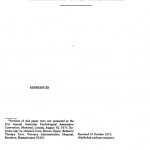Psychology
-Via Eurekalert-
Los Angeles, CA (December 7, 2010) Most people feel chills and shivers in response to music that thrills them, but some people feel these chills often and others feel them hardly at all. People who are particularly open to new experiences are most likely to have chills in response to music, according to a study in the current Social Psychological and Personality Science (published by SAGE).
Researchers Emily Nusbaum and Paul Silvia of University of North Carolina at Greensboro asked students about how often they felt chills down their spine, got goose bumps, or felt like…
Interesting...
More recent research has revealed that chimpanzees and even dogs can catch yawns from those around them, including from humans, but little is known about why we yawn and why it appears to be so infectious.
Psychologists at the University of Stirling, however, have now discovered that infants and young children are not prone to the contagious aspect of yawning. Instead, they only ever yawn spontaneously.
Dr Jim Anderson, a reader in psychology at the University of Stirling who led the research, which is published in the Royal Society journal Biological Letters, believes the…
Enjoy this article. It's some thrilling reading!
Brilliant!
-via... well I'm not really sure what this is-
Find out right here via the Christian Science Monitor:
For many years, the National Football League has given the Wonderlic aptitude test to rookie players. The test has 50 questions with a 12-minute time limit. Put three minutes on the clock and try our shortened version of the test, created with sample questions from espn.com and testprepreview.com. Multiply the number of right answers you get by 3.85 to compare with full test results. Can you do better than NFL quarterbacks Aaron Rodgers (35) or Tom Brady (33) or Peyton Manning (28)? The average NFL quarterback scores 24 on the test,…
This (I guess?) accidental view of a San Francisco house really shows how steep the hills are. -Via BoingBoing-
"Håkan Dahlström got this delightful shot of one of San Francisco's steeper hills, turning his camera so that the road (and not the houses) were at level to convey the extent of the slope."
It seems that there are some cool pictures/film floating around showing some of the results of the wacky shit that the military did back in the day in order to win wars in some very very unconventional ways. Here's something NPR dug up:
The Army had a few periods of experimenting with LSD and other drugs. While not secret, these tests are not as well-known as some of the similar LSD tests conducted by the CIA, such as MK-ULTRA and Operation Paperclip, where the U.S. government recruited former Nazi scientists.
This test, circa 1958, was conducted at Edgewood Arsenal in Maryland and was part…
Just to get you ready for tomorrow's sports post (are you smarter than a quarterback?)
Athletes' Experiences of the Psychological Effects of Poor Coaching
The purpose of this study was to describe the psychological effects of poor coaching reported by collegiate, professional and semi-professional athletes.
The present study employs a qualitative research design. Existential phenomenology is a contemporary qualitative research method that seeks to describe lived experience. This research design provided the framework for understanding athletes' effects of poor coaching.
Participants (N=16)…
This guy has a very good point:
J Med Ethics. 1992 Jun;18(2):94-8.
A proposal to classify happiness as a psychiatric disorder.
Bentall RP.
Department of Clinical Psychology, Liverpool University.
Abstract
It is proposed that happiness be classified as a psychiatric disorder and be included in future editions of the major diagnostic manuals under the new name: major affective disorder, pleasant type. In a review of the relevant literature it is shown that happiness is statistically abnormal, consists of a discrete cluster of symptoms, is associated with a range of cognitive abnormalities, and…
I love accidental viewpoints. (I studied the opposite in graduate school - the optimum view).
Check these out:
Anyone care to speculate on what's actually going on?
(answer & source here)
I don't usually post anything about "that kind" of psychology but I loved these:
(via Dangerous Minds & their creator - Matthew Wilkinson)
In yesterday's post about the experience of science, I mentioned that I had both a specific complaint about the article by Alexandra Jellicoe (which I explained in the post) and a general complaint about the class in which the article falls. I want to attempt to explain the latter problem, partly because I think it will be useful, but mostly because it's stuck in my head, and I need to at least type out the explanation before I can move on to other things.
The article in question doesn't contain all of the elements I'll mention below, but I think it clearly falls into a class of articles that…
There's an interesting article in the National Post emergent from a recent study in _Brain and Behavioral Sciences_
The article, titled "The weirdest people in the world?", appears in the current issue of the journal Brain and Behavioral Sciences. Dr. Henrich and co-authors Steven Heine and Ara Norenzayan argue that life-long members of societies that are Western, educated, industrialized, rich, democratic -- people who are WEIRD -- see the world in ways that are alien from the rest of the human family. The UBC trio have come to the controversial conclusion that, say, the Machiguenga are not…
Letters and numbers are often mentally grouped together; they're both simple sets of symbols that are the building blocks for much more complex concepts, and mastering their relationships is a cornerstone of early education. But while illiteracy becomes a major social stigma almost immediately after a young person is introduced to letters, most people can proudly declare their innumeracy (aside from basics, like telling time or counting change) throughout their lives. This is doubly strange, as our ability to think about and compare sets of items of differing amounts precedes our verbal…
From "quantum teleportation" to "Superconducting Super collider", there's nothing like an unusual word or intriguing turn of phrase to draw someone into a science story. Yesterday, the New York Times' lead tech writer Nick Bilton took a shine to "charismatic megafauna," after reading a post on The Thoughtful Animal about social cognition in polar bears. For those still scratching their heads, the post's author Jason Goldman translates: "in other words, 'really cool animals.'" These are the kinds of creatures you might see anthropomorphized in a cartoon, or starring forlornly from a wildlife…
THOUGHTS and actions are intimately linked, and the mere thought of an action is much like actually performing it. The brain prepares for an action by generating a motor simulation of it, praticising its execution of the movements by going through the motions invisibly. Seeing a manipulable object such as a tool, for example, automatically triggers a simulation of using it - a mental image of reaching out and grasping it with the hand that is nearest to the handle.
Motor simulations and movements are known to influence thought processes. Magnetic stimulation of the motor cortex…
tags: psychology, behavior, pedagogy, education, learning, teaching methods, model/rival technique, Avian Learning EXperiment, Avian Language EXperiment, ALEX, researchblogging.org,peer-reviewed research, journal club
ALEX the African Grey Parrot and Dr Irene Pepperberg.
Image: The ALEX Foundation.
Like anyone who has taught science courses, and probably like anyone who has ever taught anything to a classroom in the history of mankind, I've wondered how to motivate my students to really care about the material they are learning, beyond simply "studying for the test." For example, I have…
The Origins of Kindness:
Listen to our interview with science historian Oren Harman. He's our guest in this Science Forum discussion.
Harman is a professor at Bar Ilan University in Israel.
If evolution favors the survival of the fittest, how did kindness and selflessness evolve? The search for that answer is the subject of Harman's new book, The Price of Altruism.
It tells the story of George Price, a scientist who developed an equation that explains how natural selection can favor altruistic behaviors.
As Harman writes, George Price's life and work were full of contradictions.
Disappointed…








